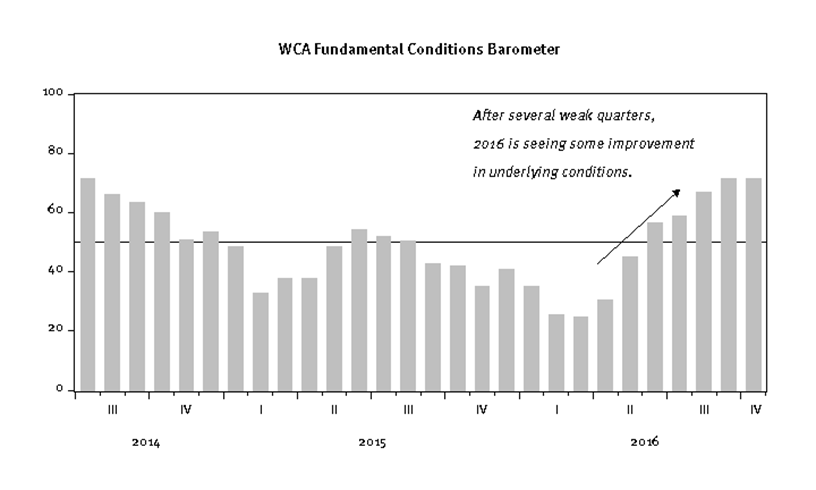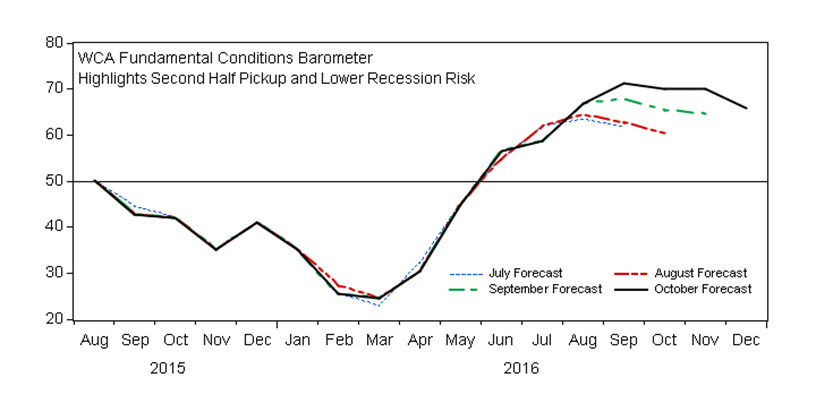Monday Morning Minute 101716
THE WEEK AHEAD
Corporate earnings are expected to contract moderately this quarter (-1.8%) for the sixth consecutive quarterly decline. However, much of the data we follow improved through the summer, suggesting potential for upside surprises. We update our forecast for the WCA Fundamental Conditions Barometer which stands near 70, reflecting improved near-term growth and lessened recession risk.
MACRO VIEW
The WCA Fundamental Conditions index showed steady improvement in recent months (Chart A), and our near-term forecast (Chart B) continues to track above 50. Barometer readings above 50 imply a higher probability of continued growth, with lessened near-term recession risk. The pickup in the barometer supported our short-term tactical call to increase equities and reduce bonds beginning last June. Bond exposure remains underweight today (and within bonds, duration is shortened), and we are overweight in corporate bonds versus Treasuries. On the equity side of the equation, our capital market assumptions lead us to remain overweight in large cap domestic growth stocks over foreign equities. We are also overweight gold, while underweight in REITs versus policy allocations.
Apart from last week’s weaker-than-expected retail sales report, most of the demand side of the economy has been decent. Rising employment and wages are helping to feed final demand, which has been growing near 2% through most of the expansion. However, we are beginning to focus more on supply constraints in the economy coming from falling productivity, lackluster investment, and slipping labor hours. This combination could pose a risk into 2017-2018. If productivity, labor, and output potentially slow while demand holds up, remaining slack will be absorbed quickly. The potential then would exist for a combination of wage pressure accelerating a downward adjustment to profits, while simultaneously putting additional pressure on the Federal Reserve (Fed) to get more aggressive on rates than currently anticipated. While this is not our base case forecast, the risk of such an outcome needs to be monitored carefully, especially given mounting constraints on central banks.
The options available to central banks a few years ago are not as obvious today. Questions about the efficacy of asset purchases, rising political opposition to easy money policies, fear of stoking asset bubbles, already negative interest rates, high levels of global private debt, and technical issues regarding managing the supply of available bonds for purchase are all conspiring to pressure central banks to back away from further aggressive easy money. While pressure may increase for some further fiscal stimulus globally, such policies are going to be hard to push through absent threat of recession or lapse into deflation. Therefore, the policy-drivers for the economy that dominated market performance since 2009 are not as strong as they once were. Instead, continued growth is increasingly tied to an improving private sector.
With some momentum behind us, what would we like to see headed into 2017? A pickup in private investment (which is lacking) would go a long way to help carry growth into 2017 by energizing the lagging supply side of the economy, helping to boost profits, and boosting the productive capacity of the economy. This would be the good way to extend the improvement seen in recent months and would provide a much needed boost to earnings growth.
Chart A
Chart B
ASSET ALLOCATION PORTFOLIO POSTURE
LONG-RUN STRATEGIC POSTURE: Our long-run forecasts lead us to overweight large cap domestic growth stocks, high-yield corporate bonds, and gold in the diversified “core” of portfolios. Underweight positions in “core” are long-term U.S. Treasuries, foreign developed equities, and REITs. The allocation in the short-term tactical “satellite” portion of portfolios currently stands at 60% equity / 40% fixed income.
_______________________________________________________________________________________
The information contained herein has been prepared from sources believed to be reliable but is not guaranteed by us and is not a complete summary or statement of all available data, nor is it considered an offer to buy or sell any securities referred to herein. Opinions expressed are subject to change without notice and do not take into account the particular investment objectives, financial situation, or needs of individual investors. There is no guarantee that the figures or opinions forecasted in this report will be realized or achieved. Employees of Stifel, Nicolaus & Company, Incorporated or its affiliates may, at times, release written or oral commentary, technical analysis, or trading strategies that differ from the opinions expressed within. Past performance is no guarantee of future results. Indices are unmanaged, and you cannot invest directly in an index.
Asset allocation and diversification do not ensure a profit and may not protect against loss. There are special considerations associated with international investing, including the risk of currency fluctuations and political and economic events. Investing in emerging markets may involve greater risk and volatility than investing in more developed countries. Due to their narrow focus, sector-based investments typically exhibit greater volatility. Small company stocks are typically more volatile and carry additional risks, since smaller companies generally are not as well established as larger companies. Property values can fall due to environmental, economic, or other reasons, and changes in interest rates can negatively impact the performance of real estate companies. When investing in bonds, it is important to note that as interest rates rise, bond prices will fall. High-yield bonds have greater credit risk than higher quality bonds. The risk of loss in trading commodities and futures can be substantial. You should therefore carefully consider whether such trading is suitable for you in light of your financial condition. The high degree of leverage that is often obtainable in commodity trading can work against you as well as for you. The use of leverage can lead to large losses as well as gains.
The WCA Fundamental Conditions Barometer measures the breadth of changes to a wide variety of fundamental data. The barometer measures the proportion of indicators under review that are moving up or down together. A barometer reading above 50 generally indicates a more bullish environment for the economy and equities, and a lower reading implies the opposite. Quantifying changes this way helps us incorporate new facts into our near-term outlook in an objective and unbiased way. More information on the barometer is found in our latest quarterly report, available at www.washingtoncrossingadvisors.com/insights.html.
Kevin Caron, Portfolio Manager Chad Morganlander, Portfolio Manager Matthew Battipaglia, Analyst
Suzanne Ashley, Junior Analyst
(973) 549-4052





